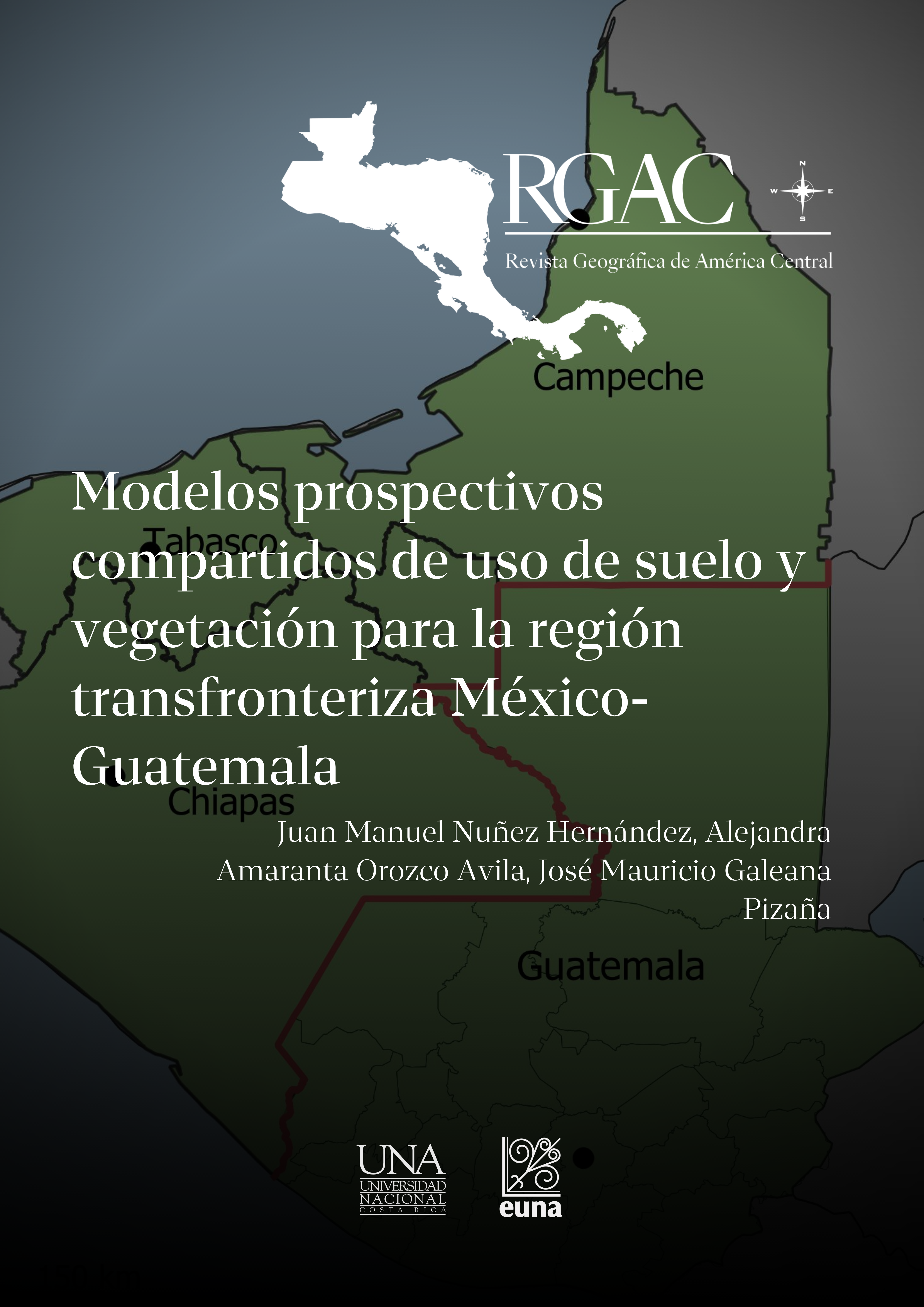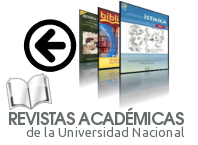Shared Prospective Models of Land Use and Vegetation for the Mexico-Guatemala Transboundary Area
DOI:
https://doi.org/10.15359/rgac.69-2.14Keywords:
land-use change, socioeconomic dynamics, drivers of change, historic analysis, trend scenario, the year 2030Abstract
The shared border between Mexico and Guatemala is a complex region to analyze due to the diverse dynamics between both countries. One threat to the area is the land-use change, where many drivers of change and environmental conditions make it a priority to analyze. This research studies the land-use changes that occurred between 1990 and 2010; these are used as a basis for constructing a trend scenario to the year 2030 through the use of the multilayer perceptron neural network. The resulting scenario shows the growth of agriculture and urban areas, as well as the loss of forests, other vegetation, and water bodies. This information highlights the need to analyze the socio-environmental implications that this could bring about.
References
Camacho, M., Molero, E. & Paegelow, M. (2010). Modelos geomáticos aplicados a la simulación de cambios de usos del suelo. Evaluación del potencial de cambio. Tecnologías de la Información Geográfica: La Información Geográfica al servicio de los ciudadanos. Sevilla: Universidad de Sevilla.
Canales A., Vargas E. & Montiel I. (2010). Migración y salud en zonas fronterizas: Guatemala y México. CEPAL.
Centro del Agua del Trópico Húmedo para América Latina y el Caribe. (CATHALAC, 1990, 2000, 2010). Series de cobertura de uso de suelo y vegetación, serie 1990, serie 2000, serie 2010 (continuo nacional), escala: 1:250000. Panamá: Centro del Agua del Trópico Húmedo para América Latina y El Caribe.
Comisión Centroamericana de Ambiente y Desarrollo. (CCAD, 2011). Atlas Centroamericano para la Gestión Sostenible del territorio. El Salvador: CCAD. Recuperado de: https://issuu.com/cathalac/docs/atlas_prevda
Degenne, P. & Lo Seen D. (2016). Ocelet: Simulating processes of landscape changes using interaction graph. SoftwareX, 5, 89-95. doi: http://dx.doi.org/10.1016/j.softx.2016.05.002
Dendoncker, N., Barnaud, C., Corbera E., Muradian, R., Silliou, N., Sirami, C., Vialatte, A., Choisis, J., Mathevet, R., Moreau, C., Reyes, V., Boada, M., Deconchat, M., Cibien, C., Garnier, S., Maneja, R. & Antona, M. (2018). Ecosystem services, social interdependencies, and collective action: a conceptual framework. Ecology and Society, 23(1):15. doi: http://dx.doi.org/10.5751/ES-09848-230115
Díaz-Pacheco, J. & Hewitt, R. (2013). Modelado de cambios de usos de suelo urbano a través de redes neuronales artificiales. Comparación de dos aplicaciones de software. GeoFocus, (14), 1-22.
Eastman, J. (2012). IDRISI SELVA, guía para SIG y procesamiento de imágenes. Clark University. Recuperado de: https://clarklabs.org/wp-content/uploads/2016/10/IDRISI-Selva-Spanish-Manual.pdf
Food Agriculture Organization. (FAO, 2018). El estado mundial de la agricultura y la alimentación. Migración, agricultura y desarrollo rural. Roma.
Figueroa Hernández, E., Pérez Soto, F. & Godínez Montoya, L. (2015). La producción y el consumo del café. España: ECORFAN. Recuperado de: https://www.ecorfan.org/spain/libros/LIBRO_CAFE.pdf
Forrester, J. (2009). Some Basic Concepts in System Dynamics. Massachusetts Institute of Technology. Recuperado de: https://www.cc.gatech.edu/classes/AY2013/cs7601_spring/papers/Forrester-SystemDynamics.pdf
Instituto Nacional de Estadística. (INE, (2002). Censos Nacionales XI de Población y VI de habitación 2002. Guatemala: Instituto Nacional de Estadística Guatemala.
Instituto Nacional de Estadística y Geografía (INEGI, 1993, 2002, 2011). Uso del suelo y vegetación, serie II, serie III y serie V (continuo nacional), escala: 1:250000. México: Dirección General de Geografía.
Instituto Nacional de Estadística y Geografía. (INEGI, 2010). Censo de Población y Vivienda 2010. México: Instituto Nacional de Estadística y Geografía.
Instituto Tecnológico y Autónomo de México (ITAM, 2014). Migración centroamericana en tránsito por México hacia Estados Unidos: Diagnóstico y recomendaciones. Informe técnico. Recuperado de: https://www.comillas.edu/images/OBIMID/itam.pdf.
Joorabian, S. & Gholamalifard, M. (2015). Scenario-based land cover change modeling and its implications for landscape pattern analysis in the Neka Watershed, Iran. Remote Sensing Applications: Society and Environment, 1, 1-19. doi: http://dx.doi.org/10.1016/j.rsase.2015.05.001
Kanevski, M., Pozdnoukhov A. & Timonin V. (2009). Machine Learning for Spatial Environmental Data: Theory, applications and software. Environmental Sciences, Environmental Engineering. Switzerland: EPLF press, Swiss Academy.
Mas, F. & Flamenco, A. (2011). Modelación de los cambios de coberturas/uso del suelo en una región tropical de México. GeoTropico, 5 (1), 1-24.
Mienmany, B. (2018). Analysis land use and land cover changes and the driving forces: A case study in Kaysone Phomvihan District, Laos. (Tesis de maestría). Universidad de Oporto.
National Research Council (NRC, 2014). Advancing Land Change Modeling: Opportunities and Research Requirements. Washington, DC: NAP.
Norman, L., Feller, M. & Villarreal, M. (2012). Developing spatially explicit footprints of plausible land-use scenarios in the Santa Cruz Watershed, Arizona and Sonora. Landscape and Urban Planning, 107, 225-235. doi: http://dx.doi.org/10.1016/j.landurbplan.2012.06.015
Ojeda, L., Bocco, G., Ezcurra, E. & Espejel, I. (2009). Land-cover/use transitions in the binational Tijuana River watershed during a period of rapid industrialization. Applied Vegetation Science, 11(1), 107-116. doi: http://dx.doi.org/10.1111/j.1654-109X.2008.tb00209.x
Ordoñez, R. & Medina, F. (2017). Modelo de calidad de hábitat y corredores para evaluación y mapeo de servicios ecosistémicos en el Complejo Sierra Madre de Chiapas. (Tesis de licenciatura). Universidad Nacional Autónoma de México.
Organización de las Naciones Unidas para la Alimentación y la agricultura (FAO) y Grupo Técnico Intergubernamental del Suelo (GTIS, 2016). Estado mundial del recurso suelo. Resumen técnico. Recuperado de: http://www.fao.org/3/a-i5126s.pdf
Pascual, U., Balvanera, P., Díaz, S., et al. (2017). Valuing nature’s contributions to people: the IPBES approach. Current Opinion in Environmental Sustainability, 26-27, 7-16. doi: http://dx.doi.org/10.1016/j.cosust.2016.12.006
Pontius, R. (2000). Quantification Error versus Location Error in Comparison of Categorical Maps. Photogrammetric Engineering and Remote Sensing, 66(8), 1011-1016.
Reyes, M. (2018). Análisis de los instrumentos de política pública y sus efectos de contención en la expansión de sistemas agropecuarios en el complejo de ANPs de la Sierra Madre de Chiapas. (Tesis de licenciatura). Universidad Nacional Autónoma de México.
Rincón, A., Echeverry, M., Piñeros, A, Tapia, C., A., David, Arias, P. & Zuluaga, P. (2014). Valoración integral de la biodiversidad y los servicios ecosistémicos: Aspectos conceptuales y metodológicos. Bogotá, D. C., Colombia: Instituto de Investigación de Recursos Biológicos Alexander Von Humboldt (IAvH).
Secretaría de Gobernación (SEGOB, 2013). Plan Nacional de Desarrollo (PND) 2013-2018. Recuperado de: https://www.snieg.mx/contenidos/espanol/normatividad/MarcoJuridico/PND_2013-2018.pdf
Secretaría de Gobernación (SEGOB, 2018). Panorama Migratorio. Migración internacional: tendencias mundiales y dimensiones del fenómeno en México. Recuperado de: https://portales.segob.gob.mx/work/models/PoliticaMigratoria/CEM/Investigacion/PM01.pdf
Secretaría de Medio Ambiente y Recursos Naturales (SEMARNAT, 2010). Atlas Geográfico del Medio Ambiente y Recursos Naturales. México.
Takaki, F. T. (2008). Información Básica para la Construcción de la Tasa de Deforestación. Dirección General de Geografía. Instituto Nacional de Estadística y Geografía. México. 43 pp.
Viera, A. & Garrett, J. (2005). Understanding Interobserver Agreement: The Kappa Statistic. Family Medicine, 37(5), 360-363. Recuperado de: https://www.ncbi.nlm.nih.gov/pubmed/15883903
Zepeda, B. (2018). Mirar al sur: México y su frontera con Guatemala. Recuperado de: https://centrosconacyt.mx/objeto/frontera-guatemala/
Zhao, C., Jensen, J. & Zhan, B. (2017). A comparison of urban growth and their influencing factors of two border cities: Laredo in the US and Nuevo Laredo in Mexico. Applied Geography,79, 223-234. doi:http://dx.doi.org/10.1016/j.apgeog.2016.12.017

Published
How to Cite
Issue
Section
License
Proposed policy for journals offering Open Access
Authors publishing their works in the Journal acknowledge and agree to the following terms:
a) Authors retain the copyrights to their works and guarantee the Journal the right to be the first to publish their works, under the Creative Commons License Attribution-NonCommercial-ShareAlike 4.0 International, CC BY-NC-SA 4.0 International (https://creativecommons.org/licenses/by-nc-sa/4.0/deed.es), which allows others to share works upon complying with the acknowledgment of authorship and mention of the Journal as the original publisher of the work.
b) Authors are permitted to separately establish additional agreements for the non-exclusive distribution of the official edition of the work published in the Journal (for example, authors may desire to place the work in an institutional repository or incorporate it into a book that is to published elsewhere) so long they acknowledgment to recognize the Journal as the original publisher. The aforementioned additional agreements must respect the terms of the non-profit character and sharing philosophy of the original license (CC BY-NC-SA 4.0 International, https://creativecommons.org/licenses/by-nc-sa/4.0/deed.es).
c) Authors are encouraged to archive the post-print or editor/PDF version in Open Access repositories.






 REVGEO is licensed under https://creativecommons.org/licenses/by-nc-sa/4.0/deed.es
REVGEO is licensed under https://creativecommons.org/licenses/by-nc-sa/4.0/deed.es
.svg_4.png)

_(1).png)
_(1)_(1)_(1)_1.png)
(2)(1)(1)(1).png)
